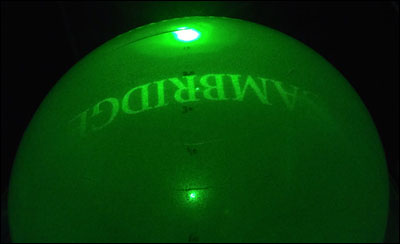
Nanotubes Project Holograms
CAMBRIDGE, England, Sept. 25, 2012 — Holograms can be generated by harnessing the conductive and light-scattering qualities of carbon nanotubes, a development that could lead to crisper projections with a larger field of view.
Many scientists believe that carbon nanotubes will be at the heart of future industry and human endeavor and will have an impact on solar cells, cancer treatments and optical imaging. One of the most astonishing features of nanotubes is that they are about 100 times stronger than steel at one-sixth the weight.
Researchers at Cambridge University’s Center of Molecular Materials for Photonics and Electronics (CMMPE) used these nanotubes as the smallest-ever scattering elements to create a static holographic projection of the word “Cambridge.”
“Smaller pixels allow the diffraction of light at larger angles — increasing the field of view. Essentially, the smaller the pixel, the higher the resolution of the hologram,” said Dr. Haider Butt of CMMPE, who conducted the work along with Yunuen Montelongo. “We used carbon nanotubes as diffractive elements — or pixels — to produce high resolution and wide field of view holograms.”

A holographic image of the word “Cambridge” generated using carbon nanotubes. (Image: Haider Butt et al)
The multiwalled nanotubes used in this study are around 700 times thinner than a human hair and are grown vertically on a layer of silicon in an atomic chimney stack formation.
The researchers calculated a placement pattern that expressed the name “Cambridge” using a variety of laser light colors, all of which were scattered from the nanoscale structures.
The holograms that resulted are not only of highest resolution, but are also ultrasensitive to changes in material and incoming light, Butt said.
“A new class of highly sensitive holographic sensors can be developed that could sense distance, motion, tilt, temperature and density of biological materials,” he said. “What’s certain is that these results pave the way towards utilizing nanostructures to producing 3-D holograms with wide field of view and the very highest resolution.”
The scientists are now looking for a less expensive alternative to nanotubes, which are financially prohibitive. Among the candidates are zinc oxide nanowires.
The team is also investigating movement in the projections. Currently, only static holograms can be rendered, but Butt and his colleagues will look at techniques such as combining these pixels with liquid crystals to create fluid displays — possibly leading to changeable pictures and even high-quality holographic video.
The findings were reported in Advanced Materials.
For more information, visit: www-g.eng.cam.ac.uk/CMMPE/
Published: September 2012